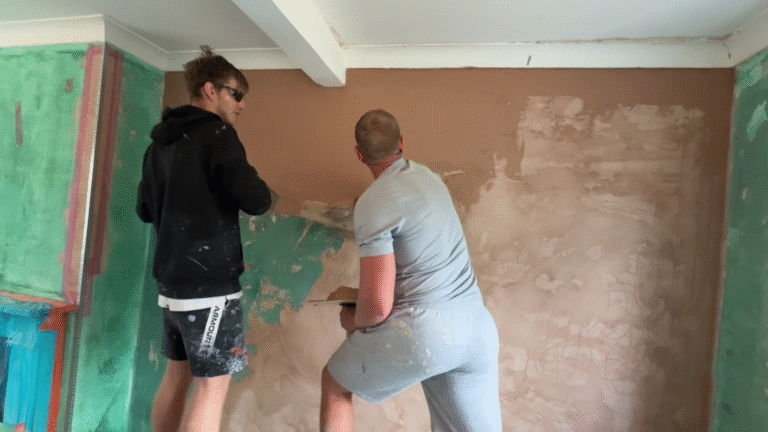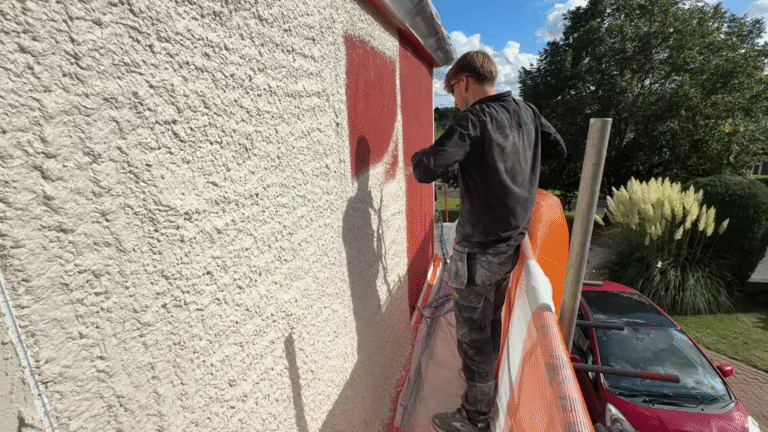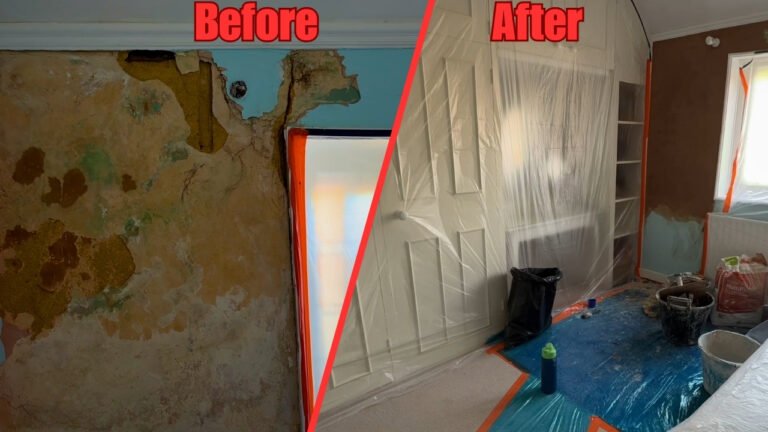Get 10% descount on first project
A Day in the Life of Plastering a Beautiful Oak Extension

A Day in the Life of Plastering a Beautiful Oak Extension
Welcome to another day on-site, where craftsmanship meets the elegance of a stunning green oak extension. In today’s blog, I’ll take you through my experience working on this unique project, sharing the challenges, tools, techniques, and some helpful plastering tips along the way.
Protecting the Oak – The First Step
The very first task upon arriving at the site is to protect the beautiful oak frame. Green oak is particularly prone to staining from water and plaster, which can result in black marks that are difficult to remove. While they can be sanded back, it’s a lot of extra work, so prevention is key.
I experimented with several types of masking tapes and found that the standard green Frog Tape worked best. It provided excellent adhesion, kept the plaster off the oak, and didn’t allow seepage. This tape made a significant difference, especially considering the oak had not been sealed.
Ceiling Challenges – Height and Angles
This extension has some beautiful architectural angles and a ceiling that reaches up to 3.5 meters. Working at that height required the use of band stands and sturdy platforms—a great combo for accessing such elevated areas safely and comfortably.
Some of the ceiling work had already been plasterboarded by the builders. While it wasn’t exactly how I would’ve done it myself, it was good enough to work with. I made sure to protect all the areas before starting the plastering process.
Managing Time with a Short Working Day
On this particular day, I had a shorter window of time due to school runs. My goal was to get a small section set and make some progress in the bathroom. Setting up strategically in two spots, I managed to tackle a bit of everything—patching, prepping, and setting.
During the setting periods, I used the downtime to prep the next day’s work: applying scrim tape to all joints and edges, and getting beads ready. It’s all about multitasking efficiently.
Working in Cold Weather
It was -2°C that day, and although the extension is indoors, it remains unheated. I did have a small radiator, which helped take the edge off. Cold conditions slow down plaster setting time, so I added some Half Time to the mix. This product essentially cuts the setting time in half, giving me a workable time of about 1.5 to 2 hours instead of the usual 3 to 3.5 hours.
Using Half Time can really help move the job along, especially when dealing with smaller sets or in colder environments.
Socket Detailing – Tips and Tricks
A common issue in plastering is aligning and detailing around sockets. In this case, one of the sockets had been slightly misaligned due to adhesive being placed unevenly underneath. To address this, I used scrim tape around the correct opening before plastering. This reinforcement mesh not only strengthens the area but also acts as a visual guide.
Once the plaster was applied and had firmed up, I carefully trimmed around the socket using a trowel for precision. Timing is key here—cutting when the plaster is still pliable avoids cracking and provides a clean, professional finish. This ensures the electrician can easily install the socket faceplates later.
Window Sills and Beading Technique
Another task was preparing the area around future window sills. Since the sills hadn’t been fitted yet, I installed a thick angle bead along the top edge. To ensure everything was level, I used a straight edge during installation.
This prep work allows the builders to come in later and fit the sills easily, with minimal making good required. A small bead of silicone may be needed underneath, but it’s a cleaner and more efficient method overall.
Tape Reviews – What Worked Best
Over the course of the job, I tested various tapes to see which held up best during plastering:
- Green Frog Tape: My top pick for protecting timber. It held firm, resisted seepage, and left no residue.
- Dark Blue Tape: Unfortunately, it didn’t hold up. It became crinkly from moisture, allowed some seepage, and may leave residue if left too long.
- Duct Tape & Cloth Tape: Useful for certain applications like rendering or sticking to brick. The high-end brick tape performed well but comes at a price.
Masking effectively can make or break the final appearance, especially when working around detailed finishes like exposed brick or timber frames.
Final Thoughts
I wrapped up the day with everything cleaned and ready for the final set tomorrow. The half-day was well spent setting, prepping, and refining details. There’s something incredibly satisfying about working in a space like this—matching modern plaster finishes with traditional oak and brick elements.
Attention to detail, the right tools, and a bit of experience can go a long way in creating a flawless finish. Whether it’s aligning sockets, protecting oak, or choosing the best tape for the job, it’s the small decisions that make a big difference.
Thanks for joining me on this day in the life. Stay tuned for more behind-the-scenes insights from the world of plastering!



